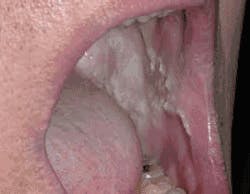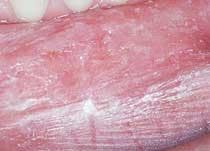Morsicatio Buccarum
by Nancy W. Burkhart, RDH, EdD
John Stevens, 40, arrives in your office for the first time in several years after being out of the country on military duty. He says he doesn"t think he was diligent in his home care while he was gone. He tells you that he is most concerned about the rough, "sandpaper-like" areas on his inside cheek and lower inner lip. They won"t heal and have been this way for some time.
As you review the health history, you learn John takes several medications. For the past few years he has been prescribed omeprazole 20 mg for an active duodenal ulcer, and also takes loratadine most of the year for his allergies. John has no other significant health history findings. He exercises but says he eats a lot of processed and fast foods because of his schedule. He"s now an engineer in a fast-paced company with a demanding schedule.
After completing an extraoral exam, you inspect the lip tissues and buccal mucosa. The tissue in these areas appear thickened, keratinized and somewhat striated (see Figures 1-2). John has extreme tissue damage along the occlusal plane and lip area next to the wet line tissues (see Figure 3). You also notice some tooth wear that could be due to bruxism.
Diagnosis: Morsicatio buccarum and morsicatio labiorum. Morsus in Latin means bite. Morsicatio buccarum is biting or chewing of the buccal mucosa, morsicatio labiorum is chewing the lip tissue, and morsicatio linguarum is chewing the borders of the tongue. The habit may involve chewing, biting, or chronic pressure of the tissues.
Etiology: Chronic trauma to the tissue causes a defense mechanism to occur in the body. The tissue responds to friction by producing keratin and becoming thickened in what is termed hyperkeratosis. Depending on the degree of trauma, the tissue may also become ulcerative and eroded in areas.
Epidemiology: Evidence of trauma may be present at select times and with varying degrees. The dental practitioner may notice hyperkeratosis during some exams and may not observe the characteristics at other times. Some patients may be chronic cheek chewers with observed areas present over many years.
Perioral and intraoral characteristics: The hyperkeratosis is usually found in the line of the occlusal plane on the tissue that contacts the teeth.The mucobuccal folds are usually not affected by the trauma because they are not contacted by the teeth and are not in the line of occlusion. The inner lip areas may also be irritated (morsicatio labiorum) and traumatized by the incisor teeth.
Distinguishing characteristics: The location and clinical appearance are diagnostic in almost all cases, and frequently the patient is aware of the habitual chewing. Depending on lifestyle factors and stress-related responses by the individual, the appearance of the tissue will vary.
Significant microscopic features: Hyperkeratosis is noted in the specimen, although biopsy is not necessary unless the areas appear different, become more intense, or fall out of what is considered a normal range. An incisional biopsy may be needed to differentiate lesions that appear out of a normal range. The specimen is usually only noted as hyperkeratosis with surface bacterial colonization.
Dental implications: Any chronic irritation is not a healthy state and may indicate underlying problems such as stress or an anxiety disorder. Determining the source of the problem may help the patient with his or her long-term health.
Differential diagnosis: Linea alba may be very distinct and may produce a heavy occlusal line. White sponge nevus is also a consideration in extreme cases. Because of the abrasion ulceration in some cases of chronic cheek chewing, deviation from the usual pattern is always a concern, especially if the patient is using tobacco and alcohol.
Treatment and prognosis: The following guidelines may help alleviate the problem and serve as practical suggestions for treating morsicatio buccarum or other frictional areas of concern. As with all extraoral and internal lesions, evaluation and monitoring is optimal. In some cases, chronic irritation may develop into more serious concerns.
About the Author
Nancy Burkhart, RDH, EdD, is an adjunct associate professor in the Department of Periodontics at Baylor College of Dentistry and Texas A & M Health Science Center in Dallas. Nancy is also a co-host of the International Oral Lichen Planus Support Group through Baylor (www.bcd.tamhsc.edu/lichen). She is the co-author of General and Oral Pathology for Dental Hygienists, published by Lippincott Williams & Wilkins in Baltimore. She can be contacted at [email protected].
Disclaimer: The author has no affiliation with the Stens Corp.
References:
Damm DD, Fantasia JE. Bilateral white lesions of buccal mucosa. Morsicatio buccarum.
Gen Dent. 2006 Nov-Dec;54(6):442,444.
Delong L, Burkhart N. General and Oral Pathology, Lippincott, Williams and Wilkins, Baltimore, 2008.
Regizi J, Sciubba J, Jordan R. Oral pathology-clinical pathologic correlations. 4th ed. St. Louis: W.B. Saunders, 2003.
Clinical Suggestions:
• First, show the patient the area of concern. Determine if the patient is aware of the morsicatio buccarum or morsicatio labiorum. Give him or her a hand mirror and use the dental lighting to observe the area together.
• Try to determine whether the patient is chewing on the area at night, during the day or at other specific times. Professionally produced night guards may be beneficial for patients who are performing the habit at night. Often the patient may also exhibit evidence of bruxism. Some shields can be fabricated and worn daily.
• If the patient is new, determine how long ago he or she has noticed the habit. If the tissue is being observed in a patient of record, review the history to determine if any notation is listed in prior visits. How long has it been documented? Chronic habits may take a long time to break.
• If it is determined to be a situational stress problem, suggest stress reduction techniques that may help the patient lower stressful situations, as well as his or her reaction to stress. Some helpful techniques may be exercise, prayer, or other techniques such as biofeedback, which teaches a person to use his or her breathing and focus to reduce stress. Personally, I like the hand-held, pocket-size device called the em-Wave that can be carried by the person and is always available. Go to https://bear.he.net/~stens/epistore/?productId=754.
• Most people with stress-related conditions are not aware they are stressed, and will tell you that they are no more stressed than anyone else. We all handle stress in different ways, and some techniques are better than others. Ultimately, success depends upon the individual. The good news is: stress reduction can be learned and coping skills can be developed.
• In certain situations, the patient may have taken anti-anxiety medications and since discontinued those medications, leading to poor health habits. Suggesting that they contact their physician or see a counselor may be appropriate, depending on the person and the clinical signs. In today"s society, many people are overwhelmed with everyday stress, and many offices report an increase in the number of people who are diagnosed with morsicatio buccarum and bruxism.
• Use intraoral photography to document the areas of concern, and use the photos for future comparison.
• If the patient uses tobacco and/or alcohol, there is further concern related to future change in the tissue and oral cancer. If the patient has not had an oral cancer screening, perform one using one of the current technologies for early detection (see Dec. 2007 RDH — Dental Exams: Are You Performing One?). If changes occur or the habit continues, careful evaluation, referral or future biopsy in some cases, is always wise.
• Develop some techniques that will make the patient aware of the habit, including:
1. Tying a ribbon, rubber band or string around the wrist, which is always helpful in behavior modification and used as a reminder to the person to check his or her own behavior.
2. Placing strategically located stickers in the home and workplace to remind the person to check their progress.
3. Visualize the word "NO" circled with an X through it, which helps the person eliminate the habit through visualization.



